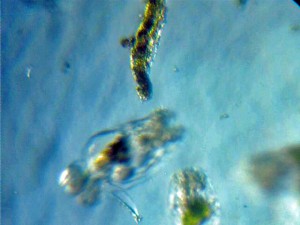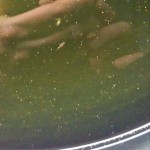Culturing rotifers is easy to do at home. In order to get started, you have to obtain a starter culture.

If you don’t find automatic success with your homegrown rotifer culture, don’t worry. It took me a few weeks (and several crashed cultures) to get the hang of it.
If you decide to try this on your own, it’s important to remember one important factoid about rotifers.
- Rotifers offer little nutritional value on their own
- The nutritional value they bring is from the food they eat
- Feed your rotifers with nutrient-loaded food like phytoplankton
Rotifers are non-selective filter feeders. That basically means that they are like my Uncle Frank–they will eat anything that will fit in their mouths. Just because they will eat anything doesn’t mean you should feed them anything. The key to successful rotifer culture is to feed them a high quality, nutrient-rich food.
Step 1: Get a Starter Culture
To culture saltwater rotifers at home, you need a starter culture. If you’re thinking…
I wouldn’t need to learn how to culture live rotifers if I already had access to live rotifer cultures…
Then I would say you have a good sense of humor–but don’t pull the old which came first, the chicken or the egg routine on me.
Try to find a hobbyist (or breeder) growing rotifers locally and ask if you can buy or trade for a small culture. If you can’t find someone locally with a stash of rotifers, you can find them online—just type ‘rotifer cultures’ or ‘live rotifers’ into GOOGLE and you’ll find a number of listings.
Make sure you get saltwater rotifers!
The most commonly available rotifer species is Brachionus plicatilis, commonly known as large strain saltwater rotifers.
Step 2: Get the right equipment
If you’re in this hobby–I already know you love equipment. I know you could get some high-end gear to culture rotifers, but what I will show you below is the equipment to create a DIY rotifer culturing station. Some of this equipment you may already have around the house.
Equipment List for Culturing Live Saltwater Rotifers at Home
- Air pump—large enough to aerate the cultures
- ~10 ft. Flexible airline tubing
- ~ 3 ft. Rigid airline tubing
- Multi-outlet airline splitter/valve
- 1-7 x 2L bottles
- Aquarium salt (cheapest you can find)
- Rotifer food (commercial or phytoplankton)
- Rotifer sieve (~ 50-micron mesh)
You will notice that the equipment to culture rotifers, is much like the equipment needed to culture phytoplankton. One of the major differences is that you don’t need a specific light source (other than room lighting) to culture rotifers.
Step 3: Set Up The Culture
The biggest decision you have to make when setting up the culture is to decide whether you want to grow your little critters continuously or in batches.
If your end-game is to have a continuous rotifer culture:
- Connect the rigid airline tubing to the flexible airline tubing and plug it into your air pump
- Add your culture to your 2-liter bottle
- Insert the rigid airline tubing into your bottle and adjust the flow of bubbles with the needle valve so that the culture is bubbling vigorously
- Feed your rotifers with liquid phytoplankton. The key is to add enough phyto so that you can see it (tint the water green). Then feed again in 12-24 hours when you see the water has cleared
- Wait about 4-5 days and then use the sieve to begin harvesting your rotifers
If you want to set up a batch culture system
- Follow steps 1-5 above, but set up 4-7 cultures. The key is to get them started about a day apart–so that you are able to a batch of rotifers completely each and every week.
For maximum nutritional value, harvest while the culture is still tinted light green.
Batch vs. Continuous cultures: The Pros and Cons
Pros
Continuous Cultures:
- Rotifers are available for harvest and use every day
- Small equipment footprint—all your equipment can potentially fit in a compact area since you will primarily be culturing in only one or two vessels
- Relatively larger volumes of cultures have the potential to be more stable and be insulated against small swings in water parameters
- You will eventually develop a fast, streamlined process to perform the maintenance duties since you will have to keep up with maintenance every day
Batch Cultures:
- Rotifers are produced at the highest densities possible.
- Since the majority of the culture volume is turned over every few days, crashes are less of a risk
- Maintenance is only required a few times per week, depending on how many cultures you are running and what the timing between the harvest of each culture
Cons
Continuous Cultures:
- Continuous cultures run at lower densities than batch cultures—as a result, you produce fewer rotifers per Liter of culture media
- Crashing—continuous cultures may crash from time to time—if you don’t have a back-up (redundant) culture running you may have to start over from scratch
- Continuous rotifer cultures require continuous maintenance. The work-load is spread out since you will perform a little bit of work every day, but you may have culture crashes if you miss too many days in a row.
Batch Cultures:
- The culture must be harvested within a day or two of reaching the top density if not, the culture will run out of food, oxygen, and crash
- You will definitely need multiple (redundant) cultures unless you plan to harvest just one day a week
Where to get a live rotifer culture online
You can find live starter cultures on eBay–or check out the Florida Aqua Farms website. I have no affiliation with them–I just know that’s where I have purchased aquaculture products like this in the past.
——————————————————————————————————————–
![]() Click here to download a free eBook: Avoid the 5 MOST COMMON Saltwater Aquarium Mistakes
Click here to download a free eBook: Avoid the 5 MOST COMMON Saltwater Aquarium Mistakes
——————————————————————————————————————–
Written by Al Ulrich




Leave a Reply